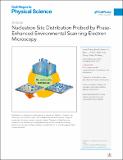| dc.contributor.author | Zhang, Lenan | |
| dc.contributor.author | Iwata, Ryuichi | |
| dc.contributor.author | Zhao, Lin | |
| dc.contributor.author | Gong, Shuai | |
| dc.contributor.author | Lu, Zhengmao | |
| dc.contributor.author | Xu, Zhenyuan | |
| dc.contributor.author | Zhong, Yang | |
| dc.contributor.author | Zhu, Jinlong | |
| dc.contributor.author | Cruz, Samuel | |
| dc.contributor.author | Wilke, Kyle L | |
| dc.contributor.author | Cheng, Ping | |
| dc.contributor.author | Wang, Evelyn N | |
| dc.date.accessioned | 2022-01-28T20:22:04Z | |
| dc.date.available | 2022-01-28T20:22:04Z | |
| dc.date.issued | 2020 | |
| dc.identifier.uri | https://hdl.handle.net/1721.1/139793 | |
| dc.description.abstract | © 2020 The Author(s) Nucleation site distribution is ubiquitous in many natural and industrial processes, such as liquid-to-vapor phase change, gas-evolving reactions, and solid-state material growth. However, a comprehensive understanding of nucleation site distribution remains elusive. These limitations are due to the challenge of probing micro/nanoscopic nucleation sites and inadequate statistical interpretation of the nucleation process. Here we report direct experimental observation of nucleation site distribution in droplet condensation using phase-enhanced environmental scanning electron microscopy. We also use statistical theory to demonstrate that the population of nucleation sites is governed by the Poisson distribution, whereas the nearest-neighbor distance follows the Rayleigh distribution instead of the commonly used Poisson distribution. We further show the broad applicability of these insights into nucleation site distribution to hydrogen-evolving reactions and chemical vapor deposition. Our platform, combining precise characterization and theory, advances the fundamental understanding of nucleation phenomena and guides designs from materials to devices. Nucleation is a ubiquitous phenomenon in nature and industry. However, the distribution of nucleation sites, which determines the macroscopic transport properties of various systems, remains elusive. Zhang et al. directly probe nucleation site distribution using phase-enhanced environmental scanning electron microscopy. Unified nucleation site distribution for multidisciplinary fields is demonstrated. | en_US |
| dc.language.iso | en | |
| dc.publisher | Elsevier BV | en_US |
| dc.relation.isversionof | 10.1016/J.XCRP.2020.100262 | en_US |
| dc.rights | Creative Commons Attribution-NonCommercial-NoDerivs License | en_US |
| dc.rights.uri | http://creativecommons.org/licenses/by-nc-nd/4.0/ | en_US |
| dc.source | Elsevier | en_US |
| dc.title | Nucleation Site Distribution Probed by Phase-Enhanced Environmental Scanning Electron Microscopy | en_US |
| dc.type | Article | en_US |
| dc.identifier.citation | Zhang, Lenan, Iwata, Ryuichi, Zhao, Lin, Gong, Shuai, Lu, Zhengmao et al. 2020. "Nucleation Site Distribution Probed by Phase-Enhanced Environmental Scanning Electron Microscopy." Cell Reports Physical Science, 1 (12). | |
| dc.contributor.department | Massachusetts Institute of Technology. Department of Mechanical Engineering | |
| dc.relation.journal | Cell Reports Physical Science | en_US |
| dc.eprint.version | Final published version | en_US |
| dc.type.uri | http://purl.org/eprint/type/JournalArticle | en_US |
| eprint.status | http://purl.org/eprint/status/PeerReviewed | en_US |
| dc.date.updated | 2022-01-28T20:04:56Z | |
| dspace.orderedauthors | Zhang, L; Iwata, R; Zhao, L; Gong, S; Lu, Z; Xu, Z; Zhong, Y; Zhu, J; Cruz, S; Wilke, KL; Cheng, P; Wang, EN | en_US |
| dspace.date.submission | 2022-01-28T20:04:59Z | |
| mit.journal.volume | 1 | en_US |
| mit.journal.issue | 12 | en_US |
| mit.license | PUBLISHER_CC | |
| mit.metadata.status | Authority Work and Publication Information Needed | en_US |
